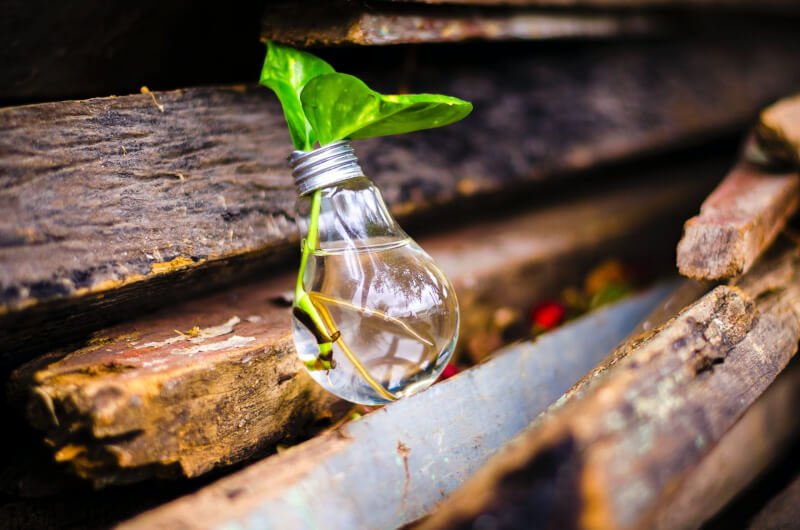Are you a proud chameleon owner or considering bringing home one of these fascinating creatures? If so, you may find yourself wondering, “What kind of lighting is best for a chameleon?” Well, fret not, dear reader, for in this article, we shall explore the ideal lighting options that will provide your chameleon with the perfect balance of warmth and UVB rays to ensure its health and happiness. So, let us shed some light on this important topic and discover the illuminating secrets to keeping your chameleon thriving!

Types of Lighting Options
Incandescent Bulbs
Incandescent bulbs are a popular choice for general lighting in homes, but they are not the ideal option for chameleons. These bulbs emit a warm, yellow light that may not provide the necessary spectrum of light that chameleons need. They also emit a significant amount of heat, which can be detrimental to the health of your chameleon if not properly managed.
Fluorescent Bulbs
Fluorescent bulbs are a better option for chameleons as they provide a broader spectrum of light that closely mimics natural sunlight. They come in different types, including compact fluorescent lights (CFLs) and linear fluorescent lights (T5 and T8). These bulbs are energy-efficient and produce less heat, making them a safer choice for your chameleon’s enclosure.
LED Bulbs
LED bulbs are another viable option for chameleon lighting. They are energy-efficient, long-lasting, and produce little to no heat, making them safe for use in an enclosure. LED bulbs also provide a wide spectrum of light that chameleons require for their well-being. However, it’s important to note that not all LED bulbs are suitable for reptile lighting, so choosing the right one specifically designed for reptiles is crucial.
Halogen Bulbs
Halogen bulbs are not typically recommended for chameleon lighting. These bulbs emit a high amount of heat and a narrow spectrum of light, which may not meet the needs of your chameleon. While they can provide intense and focused light, the risk of overheating and inadequate light spectrum often outweighs their benefits for chameleon enclosures.
UVB Lighting
Importance of UVB Lighting
UVB lighting is essential for the health and well-being of chameleons. UVB rays are responsible for the synthesis of Vitamin D3 in their skin, which is crucial for proper calcium absorption and bone development. Without adequate UVB exposure, chameleons can develop metabolic bone disease and other health issues. Therefore, providing the correct UVB lighting is crucial to ensure their overall health.
Types of UVB Lighting
There are various types of UVB lighting available for chameleons, including fluorescent bulbs and mercury vapor bulbs. Fluorescent UVB bulbs are most commonly used and are available in different intensities to suit the specific needs of your chameleon. Mercury vapor bulbs, on the other hand, provide a high level of UVB output and heat, making them suitable for larger enclosures or outdoor setups.
UVB Bulb Placement
The placement of UVB bulbs is vital to ensure maximum benefit for your chameleon. Ideally, the bulb should be mounted inside the enclosure, positioned at a distance of about 12-18 inches from the basking spot. This distance allows for proper UVB exposure without risk of overheating. It’s important to regularly monitor the UVB output from the bulb and replace it according to the manufacturer’s recommendations to ensure your chameleon receives adequate UVB exposure.
Basking Lighting
Importance of Basking Lighting
Basking lighting is crucial for chameleons as it provides the necessary heat to regulate their body temperature. Chameleons are ectothermic, meaning they rely on external sources of heat to maintain their body temperature. Without proper basking lighting, they may not be able to thermoregulate effectively, which can lead to a range of health problems.
Types of Basking Lights
There are several types of basking lights available, including incandescent bulbs and ceramic heat emitters (CHEs). Incandescent bulbs can provide both heat and visible light, making them a popular choice for basking lighting. On the other hand, ceramic heat emitters are solely designed to emit heat without any visible light, making them suitable for nighttime heating.
Basking Light Placement
The placement of the basking light is crucial to provide the right temperature gradient for your chameleon. It should be placed above a basking spot within the enclosure, allowing your chameleon to access the heat source easily. Using a thermometer, monitor the temperature at the basking spot to ensure it falls within the appropriate range for your chameleon’s species. Adjust the height or wattage of the bulb accordingly to achieve the desired temperature.
Color Temperature
Understanding Color Temperature
Color temperature refers to the appearance of light, whether it appears warm or cool. It is measured in Kelvin (K). For chameleons, it is important to choose lighting options that closely resemble the natural color temperature of the sun. A higher color temperature, around 5000K to 6500K, provides a cooler, bluish light, while a lower color temperature, around 2500K to 3000K, offers a warmer, yellowish light.
Ideal Color Temperature for Chameleons
When it comes to chameleon lighting, a color temperature between 5000K to 6500K is generally recommended. This range closely mimics the natural sunlight, allowing chameleons to receive the right spectrum of light for their physiological needs. It’s important to choose bulbs specifically designed for reptiles that provide the appropriate color temperature to ensure your chameleon’s well-being.

Intensity
Need for Light Intensity
Light intensity plays a crucial role in the overall health and behavior of chameleons. It affects their ability to thermoregulate, as well as their appetite, reproductive behavior, and overall activity levels. Insufficient light intensity can lead to vitamin deficiencies, stress, and reduced immune function. Therefore, it is important to provide appropriate light intensity in their enclosure.
Adjusting Light Intensity for Chameleons
Different chameleon species have varying light intensity requirements. Research the specific needs of your chameleon’s species to determine the appropriate light intensity. This can be achieved by selecting bulbs with different wattages or adjusting the distance between the bulb and the basking spot. Regularly monitor your chameleon’s behavior and consult with a reptile veterinarian to ensure optimal light intensity for their specific needs.
Lighting Schedule
Establishing a Lighting Schedule
A consistent lighting schedule is essential for chameleons to maintain their natural circadian rhythm. They require a cycle of light and darkness to simulate their natural environment. A typical lighting schedule involves providing 10-12 hours of light followed by 10-12 hours of darkness. This helps regulate their sleep patterns and allows them to engage in natural behaviors.
Duration of Lighting
The duration of lighting can vary depending on the specific needs of your chameleon. Some chameleons may require longer exposure to UVB lighting, especially if they have limited access to natural sunlight. However, it is important to strike a balance and avoid excessive exposure to avoid potential health risks. Consult with a reptile veterinarian or do thorough research to determine the appropriate duration of lighting for your chameleon.

Avoiding Overheating
Preventing Overheating Risks
Overheating can be a significant risk for chameleons, as they are susceptible to heat stress and dehydration. To prevent overheating, it is crucial to maintain proper heat dissipation within the enclosure. Ensure adequate ventilation and airflow to prevent the buildup of excessive heat. Monitor the temperature regularly and make adjustments to lighting or enclosure setup if needed.
Heat Lamp Placement
When using heat lamps or basking lights, it is important to position them in a way that allows for a temperature gradient within the enclosure. This ensures that your chameleon can move to warmer or cooler areas as needed to regulate its body temperature. Avoid placing the heat lamp too close to perches or foliage to prevent the risk of burns or accidental contact by your chameleon.
Dimming and Timer Controls
Benefits of Dimming and Timer Controls
Dimming and timer controls offer several benefits when it comes to chameleon lighting. They allow you to mimic natural light transitions, such as sunrise and sunset, which can help regulate your chameleon’s natural behaviors. Dimming controls also provide the ability to adjust the light intensity throughout the day, providing the optimal lighting conditions for your chameleon’s needs.
Choosing the Right Controls
When selecting dimming and timer controls, ensure compatibility with the lighting options you choose for your chameleon. Some lighting systems come with their own built-in controls, while others may require separate control units. Consider factors such as ease of use, programmability, and reliability when choosing the right controls for your chameleon’s lighting setup.

Availability and Cost
Comparing Cost and Availability of Lighting Options
The cost and availability of different lighting options can vary significantly. Incandescent bulbs are the most widely available and cost-effective option, but they may not meet the specific needs of chameleons. Fluorescent bulbs and LED bulbs are also readily available and offer a better spectrum of light, but they may come at a slightly higher cost. Mercury vapor bulbs are typically more expensive, but they provide both UVB and heat, making them suitable for larger setups.
Consider your budget and your chameleon’s specific requirements when selecting the appropriate lighting option. Remember, it’s crucial to choose quality lighting options that prioritize your chameleon’s health and well-being, even if it means a slightly higher upfront cost.
Consulting a Reptile Veterinarian
Seeking Professional Guidance
While this article provides a comprehensive overview of chameleon lighting, it is always beneficial to seek professional guidance from a reptile veterinarian. They can provide personalized advice based on your chameleon’s specific needs, species, and habitat setup. A reptile veterinarian can also help you address any concerns or challenges you may encounter with lighting, ensuring you provide the best possible lighting conditions for your chameleon’s overall health and happiness.
Remember, providing the right lighting for your chameleon is crucial for their overall well-being. By understanding the different types of lighting options, the importance of UVB and basking lighting, color temperature, light intensity, and other factors, you can create a comfortable and healthy environment for your beloved chameleon.



